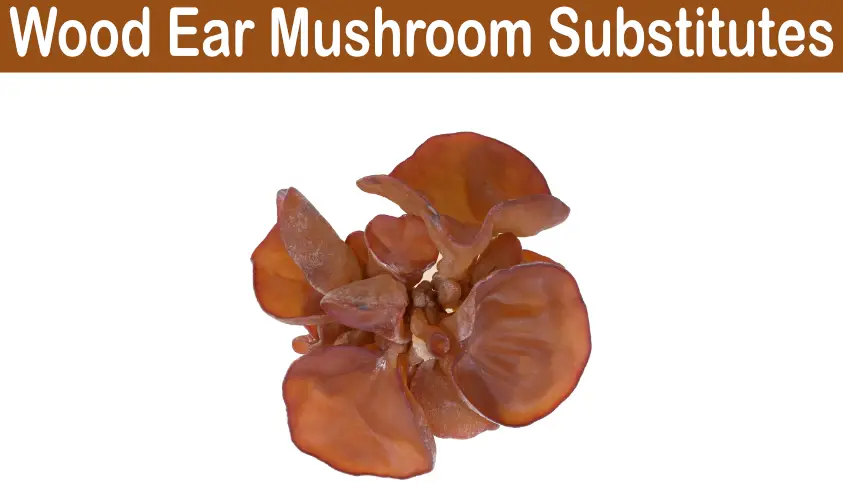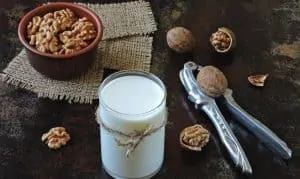The wood ear mushroom comes from the genera Auricularia and is one of the most popular edible mushrooms.
The name is derived from its unique shape resembling an ear that is common in fungi. It can be found on old trees and logs that are decaying to the point where there are piles of broken-down wood.
It is usually used to add flavor to stir-fry dishes. In contrast with other mushrooms, this one does not have the hard flesh texture and there are no stems present.
You can find this mushroom commonly in both fresh and dehydrated forms.
However, if wood ear mushroom is not available in your area or you are allergic to it then here are the best substitutes for it.

Bamboo fungus
Bamboo fungi have a good taste and make a good substitute for wood ear mushrooms. They are very similar to wood ear mushrooms in texture.
The main difference between these two types of fungi is the fact that bamboo fungi have long stems attached to their heads. This means that the ends of the stems are not as thick or plump as those of wood ear.
But, overall, this does not impair the flavor or appearance of the end product because they look exactly like wood ears when cooked correctly. Preparation of bamboo fungi is similar to preparing wood ear mushrooms.
Bamboo Fungus is easily available at Chinese restaurants or supermarkets. However, it is not as common as wood ear mushrooms and therefore may be more expensive.
Bamboo fungi are usually labeled “blessed fungus”. The proper way to purchase these fungi is to choose very fresh specimens with a pale color and firm texture.
This type of mushroom should never be brown/white in color because this means it has been kept for a very long time or that it has been dried, which will ruin the taste and texture.
Recipe
The most common way of cooking bamboo fungus is to cook it with fish. The best way to do this is to stir-fry the ingredient in a wok or a saucepan with enough S.I oil (or vegetable oil if you don’t want to add too much s.i) until cooked through (usually 4-5 minutes).
If bamboo fungus is being cooked with minced meat or fish, then leave it for another few minutes, allowing the meat and/or fish to become completely cooked; add salt if necessary and stir everything together until well blended.
You can also stir fry bamboo fungus with any vegetables you prefer [usually used with pea shoots] and seasonings, such as bean sauce. However, the way to do this is the same as stir-frying bamboo fungus with minced meat or fish.
The bamboo fungus can also be served with rice and steamed or pickled vegetables. This is the same way that one would prepare bamboo fungi for a soup dish.
That is boiling it in some water (both heads/stems and roots together) if it has been previously soaked for about half an hour before cooking; otherwise boiling it directly in a saucepan until cooked (usually takes about 10 minutes).
Cloud Ear Mushrooms (Black fungus)
The only difference between a cloud ear mushroom and wood ear mushrooms is the type of fungus.
Cloud ears are usually found in the spring season. They are also suitable for those who suffer from allergies because they have no harmful proteins, unlike wood ear mushrooms.
And cloud ear mushrooms are also firmer than wood ear mushrooms. Cooking Cloud ear mushrooms is similar to cooking wood ear mushrooms. Cloud Ear Mushrooms can be eaten raw or used in, for example, stir-fried vegetable dishes.
Cloud Ear Mushrooms can be purchased at some supermarkets [condiments department] or department stores. They should be soaked in water overnight to make them soft and then they will resemble the appearance of a cloud (hence their name).
In the following recipe, dried black fungus is used as the main ingredient.
Ingredients:
Dried black fungus (to be soaked in water for about 20 minutes before it is cooked)
- Scallions (1/2 piece of spring onion)
- Corn starch mixed with enough water to dissolve (1 cup)
- S.I. oil
- Egg white (1 egg)
- Salt to taste
Directions:
To begin with, mix two tablespoons of cornstarch with enough water to make a thick paste. Set aside.
Wash dried black fungus thoroughly and cut it into 1-inch pieces. Put them in a bowl and pour enough water to cover them; leave them for 10 minutes to soften slightly.
Next, pour enough hot water over the mushrooms again to cover them completely; this time wrap a cloth around the mushrooms and leave it for another 10 minutes.
Afterward, drain the mushrooms and transfer them to a bowl containing scallions (finely sliced). Pour enough S.I oil into a wok over medium heat; stir-fry vegetable ingredients until they are cooked through (about 5 minutes).
Next, add egg white (*) to the vegetable mix to make it firm but not dry. Stir the mixture until it is well blended. Add enough S.I oil to the mixture to form a savory sauce; heat by stirring the sauce by hand until it begins to bubble.
Add cornstarch paste and stir over medium heat until the paste becomes thick; add salt to taste and continue stirring while heating gently and slowly, until everything absorbs some of the oil.
It takes about 2 minutes for this process to be complete once you stir in all of the ingredients. Remove wok from heat once it boils and serve immediately.
The above-mentioned recipe is only a basic one and it can be made into different recipes which mostly contain wood ear mushrooms.
Examples include; stir-fried vegetables with black fungus, spicy bean sauce, etc [All recipes should follow the same method of cooking].
Note: An egg white is used to make the dish more delicate; it can also be mixed with a little vinegar and it will become more clear and turn a milky white color.
Dried enoki mushrooms
Dried Enoki Mushrooms are a great alternative for wood ear mushrooms. They can be purchased at Asian food stores.
They must be thoroughly rinsed and soaked in water before use to avoid leaving any residue behind.
Just follow the same cooking instructions as with wood ear mushrooms – they should absorb little or no oil and be soft to the bite when cooked.
Dried enoki mushrooms are also a cheaper alternative, which makes them an environmentally friendly option as well!
Smoked tofu
Another type of substitute for wood ear mushrooms is smoked tofu. Smoked tofu can be purchased from Chinese grocery stores, Asian food stores, or even some health food shops.
The advantage of this product to the more expensive ones is that there is no need to soak it before it’s used in recipes. Simply thin slices are cut and they will soften as it’s cooked with the other ingredients. It is usually cut into thin slices.
Also, it can be added to cooked dishes with oil and water to add flavor and texture. It has a firm consistency and holds its shape well when stir-fried.
Smoked tofu is also great in soups as it can absorb flavors well. You can add it in place of wood ear mushroom if you don’t have any or just want something different.
When cooking, it is best cooked dry. If you cook it with sufficient water and oil (the same amount of oil needed to fry the mushroom) it will be soggy and watery.
It will also become too soft. Smoked tofu can be used in combination with just about anything, but especially with vegetables.
If you want to add some crunch to the dish, add more smoked tofu than needed before adding other ingredients like meat or beans.
If you don’t have any, it can also be marinated and added in place of wood ear mushrooms. It’s a great vegetarian substitute for meat dishes.
Dried white fungus
Dried white fungus is a suitable alternative for wood ear mushrooms. These are usually sold in the produce section but you may also find it with the other healthy foods or unpackaged items since it is used as a dietary supplement and medicine.
You will need to soak these in water before use but not for long – around 15 minutes is enough. After they have been soaked, they should be cut into thin slices before cooking them with oil, meat, and vegetables.
The great thing about this type of fungus is that it absorbs flavor well without any bitter taste – just like wood ear mushroom does.
This makes them a good substitute if you don’t have any or want something different. When cooking; it is best cooked dry.
If you cook it with sufficient water and oil (the same amount of oil needed to fry the mushroom) it will be soggy and watery. It will also become too soft.
The dried white fungus can be used in combination with just about anything, but especially with vegetables.
That’s it. These are the wood ear mushroom substitutes that you can try with your recipes. I hope you find this article helpful.
Related Question
What looks like wood ear mushroom?
Amber jelly roll mushrooms are usually found on the ground in North America and Europe. They have a light brown or gray cap and stem, white gills, amber-colored flesh, and stem with a sturdy stalk. Amber jelly roll mushrooms also look like wood ear mushrooms but these two mushrooms are not the same.
Wood ear mushroom is commonly found in Asia. They have a hard texture with a brown or tan cap and withered stalk. The cap is usually shaped like an umbrella and it may have cottony fur on top. The gills are white, yellowish, and close together.
Jelly roll mushrooms do look like wood ear mushrooms; nevertheless, they should not be eaten raw because they contain amatoxins that cause illness.


